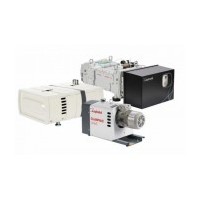In principle, a turbomolecular pump is a turbine that spins rapidly in an enclosure, where the turbine is equipped with multiple rotor blades. Between the rotating rotor blades are fixed stator disks with blades arranged in opposite directions.
Through momentum transfer from the rotating rotor blade to the gas molecules, the initial non-directional thermal motion of the gas molecules is transformed into directional motion from the pump inlet flange towards the front vacuum flange along the axial direction.
In the molecular flow range (i.e. pressure below 10-3 mbar (0.75 x 10-3 Torr)), the mean free path of the gas molecules is greater than the spacing between the rotor and stator blades (usually a few tenths of a millimeter). Accordingly, the molecules mainly collide with the optically dense rotor blades, resulting in efficient pumping. In laminar (constant) flow ranges (i.e., pressures exceeding 10-1 mbar (0.75 x 10-1 Torr)), the effectiveness of the rotor is compromised by frequent collisions between the molecules themselves.
For this reason, turbomolecular pumps cannot pump gas at atmospheric pressure.












